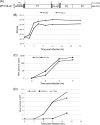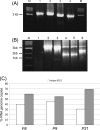Evolution of poliovirus defective interfering particles expressing Gaussia luciferase
- PMID: 22156535
- PMCID: PMC3302396
- DOI: 10.1128/JVI.05871-11
Evolution of poliovirus defective interfering particles expressing Gaussia luciferase
Abstract
Polioviruses (PVs) carrying a reporter gene are useful tools for studies of virus replication, particularly if the viral chimeras contain the polyprotein that provides all of the proteins necessary for a complete replication cycle. Replication in HeLa cells of a previously constructed poliovirus expressing the gene for Renilla luciferase (RLuc) fused to the N terminus of the polyprotein H(2)N-RLuc-P1-P2-P3-COOH (P1, structural domain; P2 and P3, nonstructural domains) led to the deletion of RLuc after only one passage. Here we describe a novel poliovirus chimera that expresses Gaussia luciferase (GLuc) inserted into the polyprotein between P1 and P2 (N(2)H-P1-GLuc-P2-P3-COOH). This chimera, termed PV-GLuc, replicated to 10% of wild-type yield. The reporter signal was fully retained for three passages and then gradually lost. After six passages the signal was barely detectable. On further passages, however, the GLuc signal reappeared, and after eight passages it had reached the same levels observed with the original PV-GLuc at the first passage. We demonstrated that this surprising observation was due to coevolution of defective interfering (DI) particles that had lost part or all of the capsid coding sequence (ΔP1-GLuc-P2-P3) and wild-type-like viruses that had lost the GLuc sequence (P1-P2-P3). When used at low passage, PV-GLuc is an excellent tool for studying aspects of genome replication and morphogenesis. The GLuc protein was secreted from mammalian cells but, in agreement with published data, was not secreted from PV-GLuc-infected cells due to poliovirus-induced inhibition of cellular protein secretion. Published evidence indicates that individual expression of enterovirus polypeptide 3A, 2B, or 2BC in COS-1 cells strongly inhibits host protein secretion. In HeLa cells, however, expression of none of the poliovirus polypeptides, either singly or in pairs, inhibited GLuc secretion. Thus, inhibition of GLuc secretion in PV-infected HeLa cells is likely a result of the interaction between several viral and cellular proteins that are different from those in COS-1 cells.
Figures








Similar articles
-
Inherent instability of poliovirus genomes containing two internal ribosome entry site (IRES) elements supports a role for the IRES in encapsidation.J Virol. 2000 Sep;74(18):8335-42. doi: 10.1128/jvi.74.18.8335-8342.2000. J Virol. 2000. PMID: 10954532 Free PMC article.
-
Complementation of a poliovirus defective genome by a recombinant vaccinia virus which provides poliovirus P1 capsid precursor in trans.J Virol. 1993 Jun;67(6):3684-90. doi: 10.1128/JVI.67.6.3684-3690.1993. J Virol. 1993. PMID: 8388519 Free PMC article.
-
Requirements for RNA replication of a poliovirus replicon by coxsackievirus B3 RNA polymerase.J Virol. 1999 Nov;73(11):9413-21. doi: 10.1128/JVI.73.11.9413-9421.1999. J Virol. 1999. PMID: 10516050 Free PMC article.
-
IRES-controlled protein synthesis and genome replication of poliovirus.Arch Virol Suppl. 1994;9:279-89. doi: 10.1007/978-3-7091-9326-6_28. Arch Virol Suppl. 1994. PMID: 8032259 Review.
-
Expanding knowledge of P3 proteins in the poliovirus lifecycle.Future Microbiol. 2010 Jun;5(6):867-81. doi: 10.2217/fmb.10.40. Future Microbiol. 2010. PMID: 20521933 Free PMC article. Review.
Cited by
-
Dengue and Zika Virus 5' Untranslated Regions Harbor Internal Ribosomal Entry Site Functions.mBio. 2019 Apr 9;10(2):e00459-19. doi: 10.1128/mBio.00459-19. mBio. 2019. PMID: 30967466 Free PMC article.
-
Seneca Valley virus replicons are packaged in trans and have the capacity to overcome the limitations of viral transgene expression.Mol Ther Oncolytics. 2023 Feb 16;28:321-333. doi: 10.1016/j.omto.2023.02.005. eCollection 2023 Mar 16. Mol Ther Oncolytics. 2023. PMID: 36938543 Free PMC article.
-
Identification of two functionally redundant RNA elements in the coding sequence of poliovirus using computer-generated design.Proc Natl Acad Sci U S A. 2012 Sep 4;109(36):14301-7. doi: 10.1073/pnas.1211484109. Epub 2012 Aug 10. Proc Natl Acad Sci U S A. 2012. PMID: 22886087 Free PMC article.
-
Enterovirus A71 DNA-Launched Infectious Clone as a Robust Reverse Genetic Tool.PLoS One. 2016 Sep 12;11(9):e0162771. doi: 10.1371/journal.pone.0162771. eCollection 2016. PLoS One. 2016. PMID: 27617744 Free PMC article.
-
Slow Infection due to Lowering the Amount of Intact versus Empty Particles Is a Characteristic Feature of Coxsackievirus B5 Dictated by the Structural Proteins.J Virol. 2019 Sep 30;93(20):e01130-19. doi: 10.1128/JVI.01130-19. Print 2019 Oct 15. J Virol. 2019. PMID: 31375587 Free PMC article.
References
-
- Aldabe R, Barco A, Carrasco L. 1996. Membrane permeabilization by poliovirus proteins 2B and 2BC. J. Biol. Chem. 271:23134–23137 - PubMed
-
- Alexander L, Lu HH, Gromeier M, Wimmer E. 1994. Dicistronic polioviruses as expression vectors for foreign genes. AIDS Res. Hum. Retroviruses 10(Suppl 2):S57–S60 - PubMed
Publication types
MeSH terms
Substances
Grants and funding
LinkOut - more resources
Full Text Sources
Other Literature Sources
Research Materials

